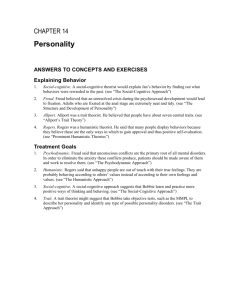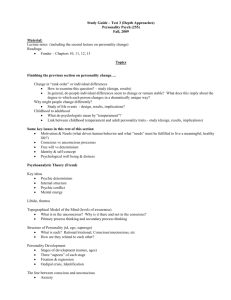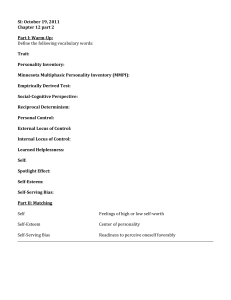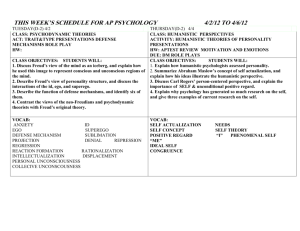AP Psychology Personality Study Guide 309
advertisement
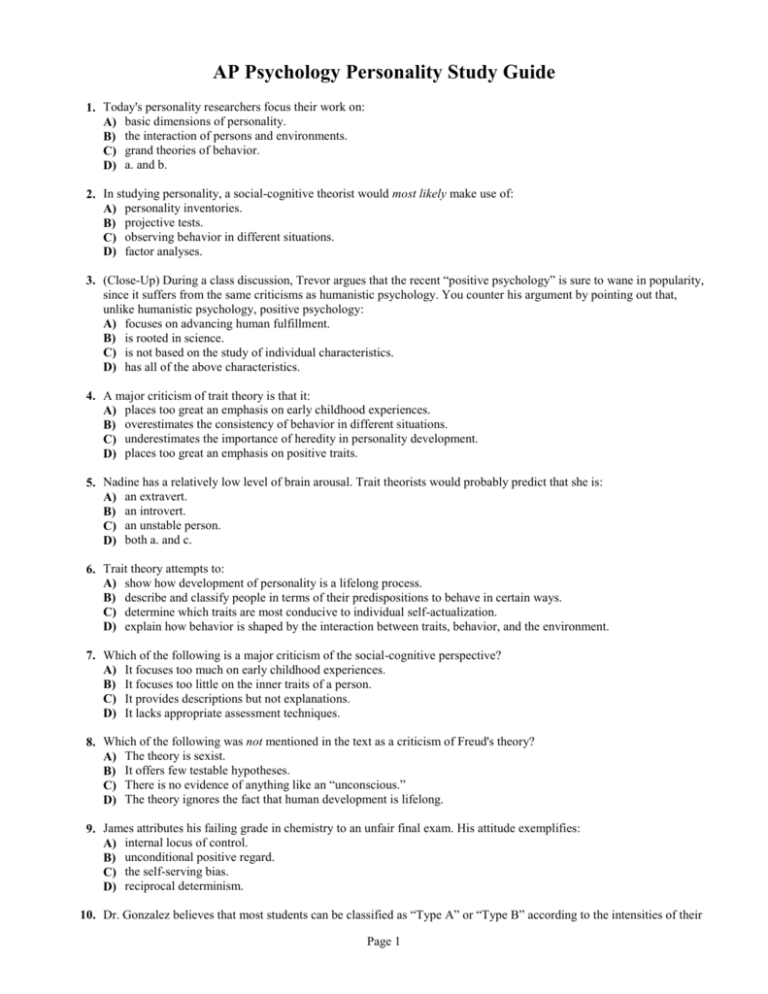
AP Psychology Personality Study Guide 1. Today's personality researchers focus their work on: A) basic dimensions of personality. B) the interaction of persons and environments. C) grand theories of behavior. D) a. and b. 2. In studying personality, a social-cognitive theorist would most likely make use of: A) personality inventories. B) projective tests. C) observing behavior in different situations. D) factor analyses. 3. (Close-Up) During a class discussion, Trevor argues that the recent “positive psychology” is sure to wane in popularity, since it suffers from the same criticisms as humanistic psychology. You counter his argument by pointing out that, unlike humanistic psychology, positive psychology: A) focuses on advancing human fulfillment. B) is rooted in science. C) is not based on the study of individual characteristics. D) has all of the above characteristics. 4. A major criticism of trait theory is that it: A) places too great an emphasis on early childhood experiences. B) overestimates the consistency of behavior in different situations. C) underestimates the importance of heredity in personality development. D) places too great an emphasis on positive traits. 5. Nadine has a relatively low level of brain arousal. Trait theorists would probably predict that she is: A) an extravert. B) an introvert. C) an unstable person. D) both a. and c. 6. Trait theory attempts to: A) show how development of personality is a lifelong process. B) describe and classify people in terms of their predispositions to behave in certain ways. C) determine which traits are most conducive to individual self-actualization. D) explain how behavior is shaped by the interaction between traits, behavior, and the environment. 7. Which of the following is a major criticism of the social-cognitive perspective? A) It focuses too much on early childhood experiences. B) It focuses too little on the inner traits of a person. C) It provides descriptions but not explanations. D) It lacks appropriate assessment techniques. 8. Which of the following was not mentioned in the text as a criticism of Freud's theory? A) The theory is sexist. B) It offers few testable hypotheses. C) There is no evidence of anything like an “unconscious.” D) The theory ignores the fact that human development is lifelong. 9. James attributes his failing grade in chemistry to an unfair final exam. His attitude exemplifies: A) internal locus of control. B) unconditional positive regard. C) the self-serving bias. D) reciprocal determinism. 10. Dr. Gonzalez believes that most students can be classified as “Type A” or “Type B” according to the intensities of their Page 1 personalities and competitiveness. Evidently, Dr. Gonzalez is working within the ________ perspective. A) psychoanalytic B) trait C) humanistic D) social-cognitive 11. Because you have a relatively low level of brain arousal, a trait theorist would suggest that you are a(n) ________ who would naturally seek ________. A) introvert; stimulation B) introvert; isolation C) extravert; stimulation D) extravert; isolation 12. For his class presentation, Bruce plans to discuss the Big Five personality factors used by people throughout the world to describe others or themselves. Which of the following is not a factor that Bruce will discuss? A) extraversion B) openness C) independence D) conscientiousness 13. Isaiah is sober and reserved; Rashid is fun-loving and affectionate. The Eysencks would say that Isaiah ________ and Rashid ________. A) has an internal locus of control; has an external locus of control B) has an external locus of control; has an internal locus of control C) is an extravert; is an introvert D) is an introvert; is an extravert 14. Which perspective on personality emphasizes the interaction between the individual and the environment in shaping personality? A) psychoanalytic B) trait C) humanistic D) social-cognitive 15. In high school, Britta and Debbie were best friends. They thought they were a lot alike, as did everyone else who knew them. After high school, they went on to very different colleges, careers, and life courses. Now, at their twenty-fifth reunion, they are shocked at how little they have in common. Bandura would suggest that their differences reflect the interactive effects of environment, personality, and behavior, which he refers to as: A) reciprocal determinism. B) personal control. C) identification. D) the self-serving bias. 16. Which of the following statements about self-esteem is not correct? A) People with low self-esteem tend to be negative about others. B) People with high self-esteem are less prone to drug addiction. C) People with low self-esteem tend to be nonconformists. D) People with high self-esteem suffer less from insomnia. 17. Which of Freud's ideas would not be accepted by most contemporary psychologists? A) Development is essentially fixed in childhood. B) Sexuality is a potent drive in humans. C) The mind is an iceberg with consciousness being only the tip. D) Repression can be the cause of forgetting. 18. According to Freud, defense mechanisms are methods of reducing: A) anger. B) fear. C) anxiety. D) lust. Page 2 19. With which of the following statements would a social-cognitive psychologist agree? A) People with an internal locus of control achieve more in school. B) “Externals” are better able to cope with stress than “internals.” C) “Internals” are less independent than “externals.” D) All of the above are true. 20. Which of the following is a common criticism of the humanistic perspective? A) Its concepts are vague and subjective. B) The emphasis on the self encourages selfishness in individuals. C) Humanism fails to appreciate the reality of evil in human behavior. D) All of the above are common criticisms. 21. Which of the following groups tends to suffer from relatively low self-esteem? A) women B) ethnic minorities C) disabled persons D) none of the above 22. Jill has a biting, sarcastic manner. According to Freud, she is: A) projecting her anxiety onto others. B) fixated in the oral stage of development. C) fixated in the anal stage of development. D) displacing her anxiety onto others. 23. Neo-Freudians such as Adler and Horney believed that: A) Freud placed too great an emphasis on the conscious mind. B) Freud placed too great an emphasis on sexual and aggressive instincts. C) the years of childhood were more important in the formation of personality than Freud had indicated. D) Freud's ideas about the id, ego, and superego as personality structures were incorrect. 24. Professor Minton believes that people strive to find meaning in life because they are terrified of their own mortality. Evidently, Professor Minton is a proponent of: A) terror-management theory. B) psychodynamic theory. C) the humanistic perspective. D) the social-cognitive perspective. 25. Projective tests such as the Rorschach inkblot test have been criticized because: A) their scoring system is too rigid and leads to unfair labeling. B) they were standardized with unrepresentative samples. C) they have low reliability and low validity. D) it is easy for people to fake answers in order to appear healthy. 26. Which of the following is the correct order of psychosexual stages proposed by Freud? A) oral; anal; phallic; latency; genital B) anal; oral; phallic; latency; genital C) oral; anal; genital; latency; phallic D) anal; oral; genital; latency; phallic 27. Research on locus of control indicates that internals are ________ than externals. A) more dependent B) more intelligent C) better able to cope with stress D) more sociable 28. Because Ramona identifies with her politically conservative parents, she chose to enroll in a conservative college. After four years in this environment, Ramona's politics have become even more conservative. Which perspective best accounts for the mutual influences of Ramona's upbringing, choice of school, and political viewpoint? A) psychoanalytic Page 3 B) trait C) humanistic D) social-cognitive 29. The Oedipus and Electra complexes have their roots in the: A) anal stage. B) oral stage. C) latency stage. D) phallic stage. 30. In promoting personality growth, the person-centered perspective emphasizes all but: A) empathy. B) acceptance. C) genuineness. D) altruism. 31. Regarding the self-serving bias, psychologists who study the self have found that self-affirming thinking: A) is generally maladaptive to the individual because it distorts reality by overinflating self-esteem. B) is generally adaptive to the individual because it maintains self-confidence and minimizes depression. C) tends to prevent the individual from viewing others with compassion and understanding. D) tends not to characterize people who have experienced unconditional positive regard. 32. Research has shown that individuals who are made to feel insecure are subsequently: A) more critical of others. B) less critical of others. C) more likely to display a self-serving bias. D) less likely to display a self-serving bias. 33. A major difference between the psychoanalytic and trait perspectives is that: A) trait theory defines personality in terms of behavior; psychoanalytic theory, in terms of its underlying dynamics. B) trait theory describes behavior but does not attempt to explain it. C) psychoanalytic theory emphasizes the origins of personality in childhood sexuality. D) all of the above are differences. 34. The text defines personality as: A) the set of personal attitudes that characterizes a person. B) an individual's characteristic pattern of thinking, feeling, and acting. C) a predictable set of responses to environmental stimuli. D) an unpredictable set of responses to environmental stimuli. 35. Andrew's grandfather, who has lived a rich and productive life, is a spontaneous, loving, and self-accepting person. Maslow might say that he: A) has an internal locus of control. B) is an extravert. C) has resolved all the conflicts of the psychosexual stages. D) is a self-actualizing person. 36. A psychoanalyst would characterize a person who is impulsive and self-indulgent as possessing a strong ________ and a weak ________. A) id and ego; superego B) id; ego and superego C) ego; superego D) id; superego 37. Wanda wishes to instill in her children an accepting attitude toward other people. Maslow and Rogers would probably recommend that she: A) teach her children first to accept themselves. B) use discipline sparingly. C) be affectionate with her children only when they behave as she wishes. D) do all of the above. Page 4 38. Seligman has found that humans and animals who are exposed to aversive events they cannot escape may develop: A) an internal locus of control. B) a reaction formation. C) learned helplessness. D) neurotic anxiety. 39. The Minnesota Multiphasic Personality Inventory (MMPI) is a(n): A) projective personality test. B) empirically derived and objective personality test. C) personality test developed mainly to assess job applicants. D) personality test used primarily to assess locus of control. 40. The behavior of many people has been described in terms of a spotlight effect. This means that they: A) tend to see themselves as being above average in ability. B) perceive that their fate is determined by forces not under their personal control. C) overestimate the extent to which other people are noticing them. D) do all of the above. 41. Recent research has provided more support for defense mechanisms such as ________ than for defense mechanisms such as ________. A) displacement; reaction formation B) reaction formation; displacement C) displacement; regression D) displacement; projection 42. According to Freud, ________ is the process by which children incorporate their parents' values into their ________. A) reaction formation; superegos B) reaction formation; egos C) identification; superegos D) identification; egos 43. According to the psychoanalytic perspective, a child who frequently “slips” and calls her teacher “mom” probably: A) has some unresolved conflicts concerning her mother. B) is fixated in the oral stage of development. C) did not receive unconditional positive regard from her mother. D) can be classified as having a weak sense of personal control. 44. A psychologist at the campus mental health center administered an empirically derived personality test to diagnose an emotionally troubled student. Which test did the psychologist most likely administer? A) the MMPI B) the TAT C) the Rorschach D) the Locus of Control Scale 45. According to Rogers, three conditions are necessary to promote growth in personality. These are: A) honesty, sincerity, and empathy. B) high self-esteem, honesty, and empathy. C) high self-esteem, genuineness, and acceptance. D) genuineness, acceptance, and empathy. 46. The school psychologist believes that having a positive self-concept is necessary before students can achieve their potential. Evidently, the school psychologist is working within the ________ perspective. A) psychoanalytic B) trait C) humanistic D) social-cognitive 47. Which of the following places the greatest emphasis on the unconscious mind? A) the humanistic perspective Page 5 B) the social-cognitive perspective C) the trait perspective D) the psychoanalytic perspective 48. The ________ classifies people according to Carl Jung's personality types. A) Myers-Briggs Type Indicator B) MMPI C) Locus of Control Scale D) Kagan Temperament Scale 49. Id is to ego as ________ is to ________. A) reality principle; pleasure principle B) pleasure principle; reality principle C) conscious forces; unconscious forces D) conscience; “personality executive” 50. The personality test Teresa is taking involves her describing random patterns of dots. What type of test is she taking? A) an empirically derived test B) the MMPI C) a personality inventory D) a projective test Page 6 Answer Key 1. 2. 3. 4. 5. 6. 7. 8. 9. 10. 11. 12. 13. 14. 15. 16. 17. 18. 19. 20. 21. 22. 23. 24. 25. 26. 27. 28. 29. 30. 31. 32. 33. 34. 35. 36. 37. 38. 39. 40. 41. 42. 43. 44. 45. 46. 47. 48. 49. 50. D C B B a B B C C B C C D D A C A C A D D B B A C A C D D D B A D B D D A C B C B C A A D C D A B D Page 7

